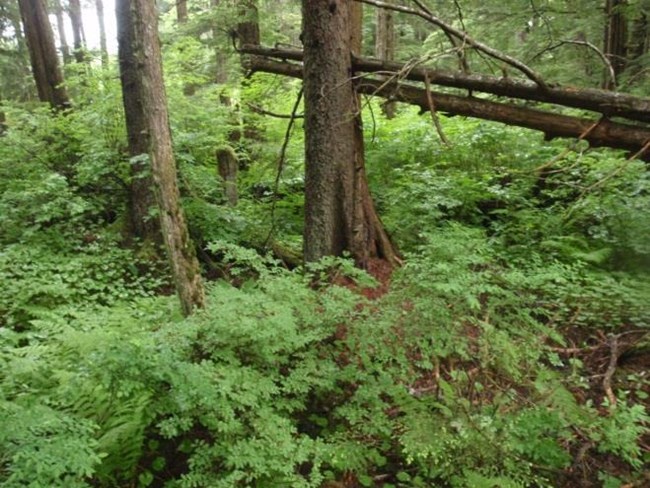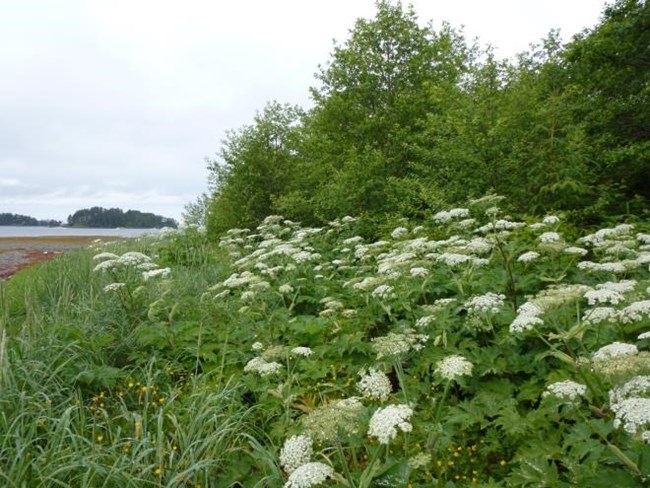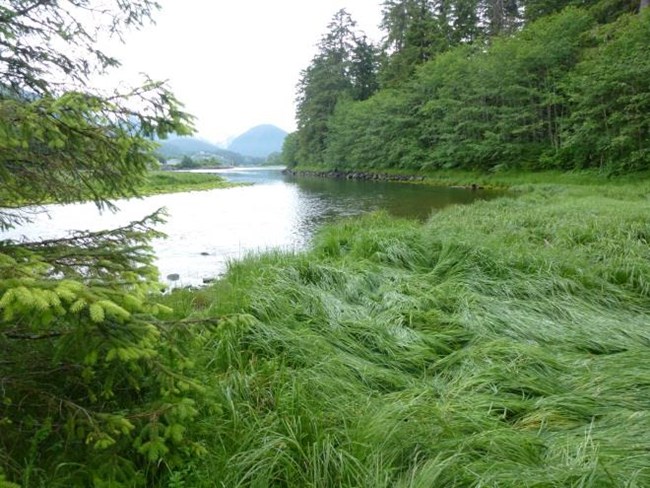|
Sitka National Historical Park ecosystems reflect the intersection of aquatic and terrestrial, salt and freshwater, lowland and upland systems creating a remarkable diversity of habitat types. The Indian River is a prominent feature that transects the park and supports both resident and anadromous fish populations. 
Uplifted Beach ForestsThe Uplifted Beach occurs in the coastal lands that are not subject to tidewaters. Vegetation is needleleaf forest dominated by western hemlock and Sitka spruce with a shrub understory comprised of berry species and Devil’s club. Soils are well-drained peat over sand and gravel. 
Sitka Spruce-Western Hemlock-Red Alder/Salmonberry Forest—A closed-canopy needleleaf forest type where Sitka spruce or western hemlock each contribute 25 to 75% to the total tree cover; red alder comprises at least 10% of tree cover. This forest ecosystem occurs on low-elevation, infrequently disturbed sites and is associated with former and current beach environments. Due to the location of this forest above tidal range, disturbances are likely limited to salt-spray and storm surges. 
Sitka Spruce-Western Hemlock/Devil’s Club Forest—A closed-canopy needleleaf forest type where Sitka spruce or western hemlock each contribute 25 to 75% to the total tree cover; red alder comprises less than 10% of tree cover and Devil’s club cover is at least 5%. Rhododendron, blueberry, and red huckleberry make up the sparse shrub layer. This forest occurs at low elevations and across relatively flat land, such as old channels of the Indian River. The most common disturbance is windthrow. Lowland ForestsThe Lowlands occurs at the highest elevation of the park, but is considered a lowland based on its position within the greater landscape. Vegetation is western hemlock forest with a shrub understory of berry species. Soils on gently sloping to level areas are poorly to well-drained peat overlying gravelly loam or sandy loam. A third soil type occurs on a bedrock knob and is a well-drained peat over sandy loam underlain by shallow greywacke. 
Western Hemlock-Sitka Spruce/Blueberry Species Forest—A closed-canopy needleleaf forest type where Sitka spruce or western hemlock each contribute 25 to 75% and red alder comprises less than 10% of tree cover. Devil’s club cover is less than 5% and berries collectively comprise more than 25% cover of the well-developed shrub layer. This forest occurs at low elevations and across relatively flat land, such as old channels of the Indian River. The most common disturbance is windthrow. 
Western Hemlock-Sitka Spruce/Depauperate Forest—A closed-canopy needleleaf forest type where western hemlock or Sitka spruce contributes 75% to the total tree cover. The understory is sparse with respect to vascular plant species; moss species comprise more than 25% of ground cover. Snags and abundant woody debris are common. This forest occurs on low-elevation, relatively flat sites within a larger matrix of mature, closed-canopy needleleaf forests; its development is driven by gap successional processes, probably related to openings created by windthrow. 
Western Hemlock/Blueberry Species Forest—A closed-canopy needleleaf forest type where western hemlock contributes 75% to the total tree cover. Blueberry species comprise more than 25% cover of the well-developed shrub layer. This is an old growth forest with a multilayered canopy, snags, and downed woody debris. It occurs at low elevations and across relatively flat land; the most common disturbance is windthrow. Floodplain ForestsThe Floodplain of the Indian River and is subject to flooding during periods of extremely high runoff (every 20 to 50 years). Vegetation is a red alder forest with salmonberry understory. Soils range from moderately to well-drained peat over sandy loam to poorly drained peat over loam. 
Red Alder-Sitka Spruce/Salmonberry Forest— A closed-canopy, mixed forest type where broadleaf or needleleaf species comprise 25-75% of the total tree cover. The dominant broadleaf species is red alder; in disturbed sites the nonnative tree, mountain ash, is often present as a minor (<25%) component of the canopy. Needleleaf species are present as a regenerative substratum comprised of Sitka spruce and, less commonly, western hemlock saplings. Salmonberry is an abundant shrub component with a lesser amount of red elderberry. The presence of Sitka spruce often indicates disturbed soil. Disturbance is most commonly related to river flooding or coastal processes such as salt spray. 
Red Alder/Salmonberry Forest—Closed canopy, broadleaf forest where red alder and mountain ash comprise for than 75% of the total tree cover with a dense shrub understory of salmonberry. This is an early successional ecosystem that likely develops from sparse floodplain vegetation and in the absence of disturbance presumably develops towards a Sitka spruce forest type. Disturbance is from river dynamics, including seasonal flooding. Uplifted Beach MeadowsThe Uplifted Beach Meadow occurs in the concave coastal lands subject to tidal flooding during extreme high tides and storm tides. Vegetation grades from beach meadow species such as American dune grass and cow parsnip to a red alder forest with salmonberry understory. Soils are well-drained beach sands and gravels. 
Tufted Hairgrass-Pacific Silverweed Halophytic Wet Meadow—A tidally influenced herbaceous wetland where grass cover is dominated by tufted hair grass and other salt-tolerant plants, such as silverweed and Alaska plantain. This wet meadow occurs in small patches along protected shores where freshwater enters the ocean. 
American Dunegrass-Large Umbel Coastal Meadow—A coastal meadow where grass cover is dominated by American dunegrass and cow parsnip. Goosegrass and fireweed are also common and abundant. This coastal meadow occurs as small linear patches along semi-exposed shorelines and protected estuary margins. Tidal disturbance is generally limited to extreme high tides and storm surges. Estuary, Tidal MarshesThe Estuary is the wetland occupying the intertidal range at the mouth of the Indian River. Vegetation is dominated by salt-tolerant grasses and forbs. Soils in the estuary are poorly drained sands and gravels. 
Lyngbye’s Sedge Tidal Marsh—A tidally influenced herbaceous wetland type comprised of nearly monotypic stands of sedge, with some arrowgrass and silverweed. This tidal marsh occurs in small patches along protected shores where freshwater enters the ocean. 
Nootka Alkaligrass Tidal Flat—A tidally influenced herbaceous type where salt-tolerant grasses, like Alaska alkaligrass, and succulent forb species such as goose tongue, Alaska saltbush, scurvy grass, and Canadian sandspurry are present. Occurring in the intertidal zone of medium- to low-energy shorelines, these sites are inundated daily to twice a day by seawater. |
Last updated: February 11, 2019
